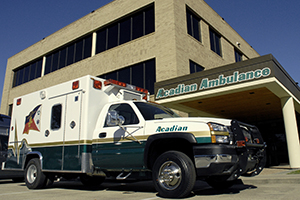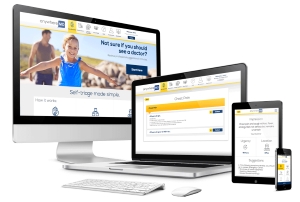Health care (eHealth) Sourcing Fundamentals
To understand why healthcare companies like to manage every process internally, including IT services, it’s helpful to remember that this industry is solely concerned with human lives. This fact imposes a huge responsibility on healthcare workers, and requires them to have deep, highly specialized knowledge. Even in the face of obvious offshore outsourcing advantages — high cost-savings, developmental flexibility, and remote team scalability — concern over the outsourcing provider's potential lack of specific eHealth and mHealth knowledge can sometimes be a dealbreaker. However, many of today’s IT outsourcing providers possess the expertise needed to meet the healthcare industry’s unique challenges. To find out why, let’s explore the “outsourcer’s hierarchy of skills”.
The hierarchy of skills
By working with different industries, IT outsourcers acquire strong general programming skills. These skills provide the basis for any collaboration, since the best applications have much in common, regardless of the specific industry:
- Clean, maintainable, extendable code: this reduces bug-fixing overtime and increases “developer independence” — that is, the code is pleasant to read and easy to understand for any developer seeing it for the first time. Good code also allows for any easy maintenance and extension foreseen at the architectural design stage, minimizes time and effort spent on technical support, and optimizes hardware resource employment
- Smart architecture: separating the data from its presentation
- Intuitive UI design: makes the user’s experience seamless and engaging
- Habit formation strategies: lead to efficient construction of apps destined to be essential everyday tools for their users
Basic programming skills represent the hierarchy’s first stage, while the second stage is represented by specific eHealth development skills, which an experienced outsourcer has most likely acquired thanks to eHealth’s growing popularity and rapid expansion. With these two stages complete, the IT provider can be considered a professional in core industry-specific standards. Specifically, he/she understands HIPAA data security standards and Good Clinical Practice (GCP, the international quality standard that protects human rights during clinical trials) compliance, and has also learned how to solve the healthcare industry’s main challenges after working with his/her first few clients. Also, the provider can speak a healthcare client’s language while developing solutions that will increase the client’s business value and improve their clinical decisions and patient care quality.
Meeting business, clinical and patient needs
Modern healthcare services’ three essential attributes are well-ensured by information technology. Coincidentally, all three attributes begin with the letter A. The first “A” stands for the accuracy of health-related data, which supports clinical decision-making. The second “A” is for access to all clinical case-relevant information, and the third stands for automation of data processing. These three As are present in every single eHealth solution and serve clinical, business and patient needs, often simultaneously.
Business needs: managing, scheduling and billing
Through business process automation, eHealth solutions bring value to healthcare providers as enterprises. Automated solutions reduce administrative burden, service costs, and patient wait-times, and simplify the evaluation of care process quality and efficiency. Hospital management systems help regulate and coordinate work; e-scheduling, booking and e-billing systems help engage new patients and keep them involved; and Electronic Medical Record (EMR) systems, the core healthcare electronic solution, reduce paperwork and confirm medical records’ legibility and integrity, while also allowing multiple users to review a record simultaneously.
Of course, a number of prerequisites must be met in order to alleviate personal medical data privacy concerns:
- Build a system with a well-engineered user-role system, a secure authorization procedure, and a carefully considered benchmark access level
- Encryption, storage and processing of all medical data
- Track all user activity in the system, including health record modifications, and create alerts for abnormal data entry
- Design an interface that minimizes mistakes
- Ensure the system’s fault-tolerance and data backup
- Ensure the data’s accessibility from the most popular web browsers and mobile devices
Clinical needs: learning, communications, EMR and visualization
Accurate health-related data and fast data access at the point-of-care are crucial to sound diagnostic and treatment decisions. To ensure these two things, a medical practice’s eHealth software should include:
- Point-of-care access to up-to-date medical database/databases: this includes practice guidelines and lists of symptoms, diagnoses, and dosage levels, so the doctor can deliver informed clinical decisions. eLearning systems should also be included for undergraduate education, ensuring a better medical education outcome, or for the continued education of full-time practitioners
- Dosage levels accessible via mobile device
- Access to a patient’s comprehensive clinical data, along with his/her electronic medical records, which aggregate the patient’s health information as recorded by different specialists, laboratories and healthcare organizations. This “complete picture” limits medical errors and increases effective clinical decisions
- Access to other healthcare professionals through a secure messaging system. This connects the patient’s primary physician to the patient’s other specialists, pharmacies and laboratories
- Access to medical imaging and health condition imagery, which is crucial for diagnosing the patient and informing the patient of symptoms. These visualizations are most demonstrable when used via mobile technologies, i.e. touchscreen and augmented reality
Patient needs: medical appointments and vital personal data
The most crucial benefit for patients is 24/7 access to healthcare services and personal health-related data through web or mobile applications. eHealth and mHealth solutions provide online appointment booking and personal medical records access that:
- Reduce stress and appointment setup time
- Provide 24/7 access to vital health-related information: immunizations, allergies, family history, medications, test results and previous diagnoses
- Ensure easy patient-physician communication
Thanks to today’s technology, every business, clinical, and patient need is met, and all relevant healthcare data is processed accurately and stored safely and comprehensively for 24/7 retrieval!
Sibers’ healthcare industry experience
Sibers has worked with the healthcare industry since 2002. We’re very proud of our long-time association, since we feel that we contribute to saving people’s lives — and that’s very inspiring!
To date, Sibers’ largest project involved the creation of a single platform that can organically combine electronic clinical data capture with clinical trial management systems. Sibers designed sophisticated software that met the Department of Health and Human Services’ (DHHS) stringent demands, allowing our client’s consulting group to focus on patient record data collection design and GCP compliance.
In total, Sibers has developed 50+ eHealth and mHealth solutions for large, multinational healthcare organizations and small healthcare startups. Most of our clients hail from North America, Australia and Scandinavia, and we’re well-acquainted with the healthcare industry standards in these regions. But we’re always looking to expand our horizons! Learn more about our eHealth solutions by visiting the Case Studies section or contacting one of our consultants.
Featured case studies developed for Health care industry
Need a development team for your eHealth project?
Request a quoteWhitepapers
- Building MVP for Startups
- Architecture: Why Does it Matter?
- Functionality vs. Classy: The “90/90 Percent” App Rule
- The Essentials of Custom Development for Printing Businesses
- IT Projects: It Takes Two To Meet A Deadline
- E-Learning Evolution: Custom E-Learning Development Trends
- Getting iOS App Crash Logs
- You Asked, We Answered: Testing, Debugging, and What on Earth Does “Best Practices” Really Mean?
- The Limits of Perfection: Where Pixel-perfectionists Need to Stop and Think
- Software cost estimation: What factors are key in IT project estimates?
- Why go outsource?
- DIY: When Does It Make Sense?



